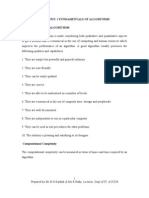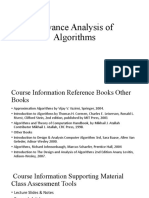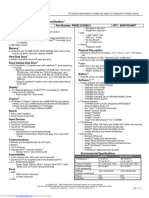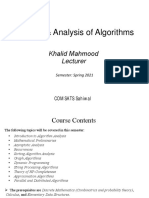0 ratings0% found this document useful (0 votes)
56 viewsAnalyzing Algorithm Complexity
This document discusses analyzing the complexity of algorithms. It explains that complexity analysis involves predicting the resources an algorithm requires, such as running time and memory usage. Time complexity is often the most important metric. The document uses insertion sort as an example, stating its worst-case running time is Θ(n^2). It also discusses asymptotic notation and the RAM model of computation used to analyze algorithms.
Uploaded by
Kezia IreneCopyright
© © All Rights Reserved
Available Formats
Download as PPTX, PDF, TXT or read online on Scribd
0 ratings0% found this document useful (0 votes)
56 viewsAnalyzing Algorithm Complexity
This document discusses analyzing the complexity of algorithms. It explains that complexity analysis involves predicting the resources an algorithm requires, such as running time and memory usage. Time complexity is often the most important metric. The document uses insertion sort as an example, stating its worst-case running time is Θ(n^2). It also discusses asymptotic notation and the RAM model of computation used to analyze algorithms.
Uploaded by
Kezia IreneCopyright
© © All Rights Reserved
Available Formats
Download as PPTX, PDF, TXT or read online on Scribd
You are on page 1/ 21
Analyzing Algorithm:
Complexity
Raja Damanik, M.Sc.
Faculty of Computer Science, University of Indonesia
Design & Analysis of Algorithms 2019
Analyzing the complexity
Analyzing the complexity of an algorithm means predicting
the resources that the algorithm requires.
Resources can mean:
Running time
Memory used
Communication bandwith
etc.
To analyze this, we do counting.
Analyzing the complexity
Sometimes, we care more about a resource than the others.
We should carefully see what resource is limited or what
kind of operation really matters and we should care about.
Most of the time, time complexity is what we care about.
Other complexity can be analyzed using similar strategy (e.g.
counting).
Time Complexity
• The running time of an algorithm depends on the number and type of
operations that are executed.
• Some examples:
• Operations on integer data
• Operations on floating point data
• Accessing an element of an array
• Function calls
• Branching
• Sometimes, a certain type of operations impacts the running time more
severely than others.
• A good analysis will give you a good prediction. A bad one will fool you.
• Having a good analysis needs a good understanding of the environment
where your algorithm runs, e.g. model of your machine, operations you
care about, etc.
RAM model
In this lecture, we will use a standard model in which algorithm in
computer science is analyzed.
We will use generic one-processor RAM (random access machine)
model of computation and implement our algorithm as computer
programs on that machine.
RAM model
RAM model: contains instructions commonly found in real
computers.
Arithmetic (add, subtract, multiply, divide, remainder, floor, and
ceiling)
Data movement (load, store, copy)
Control (conditional and unconditional branch, subroutine call and
return)
Each such instruction is assumed to take a constant amount
of time.
Supports data type: integer, floating point.
Running Time
INSERTION SORT
The running time of insertion sort is
Kinds of algorithm analysis
Assymptotic Notation
The assymptotic notation (such as 𝑂, Ω, Θ) can be used to
simplify the expression that
Is the following statement is correct or not? Discuss with
your neighbor.
The running time of insertion sort is Ω 𝑛2 .
The running time of insertion sort is 𝑂 𝑛2 .
The running time of insertion sort is Θ 𝑛2 .
The worst-case running time of insertion sort is Θ 𝑛2 .
The worst-case running time of insertion sort is 𝑂 𝑛2 .
The best-case running time of insertion sort is Θ 𝑛 .
The best-case running time of insertion sort is 𝑂 𝑛 .
Running time of recursive algorithm
Pseudocode of merge sort
Merge procedure
Exercise
Find the loop invariant of the code fragment 6-
12 from lines 6 to 12 and prove its correctness.
Solving recurrences
• Once we can describe the recurrence for the running time
of an algorithm, we can use the technique from Solving
Recurrences to find the assymptotic tight bound to solution.
• The merge-sort algorithm has running time 𝑇 𝑛 = Θ 𝑛 lg 𝑛 .
You might also like
- Unit: I Fundamentals of Algorithms The Analysis of AlgorithmsNo ratings yetUnit: I Fundamentals of Algorithms The Analysis of Algorithms12 pages
- CS-311 Design and Analysis of AlgorithmsNo ratings yetCS-311 Design and Analysis of Algorithms24 pages
- Introduction and Elementary Data Structures: Analysis of AlgorithmsNo ratings yetIntroduction and Elementary Data Structures: Analysis of Algorithms12 pages
- Design and Analysis of Algorithms Note by Bhupendra Singh SaudNo ratings yetDesign and Analysis of Algorithms Note by Bhupendra Singh Saud98 pages
- Analysis of Algorithms - 12112014 - 054619AMNo ratings yetAnalysis of Algorithms - 12112014 - 054619AM21 pages
- Design and Analysis of Algorithms: Lecture 1 - 2No ratings yetDesign and Analysis of Algorithms: Lecture 1 - 2109 pages
- Chapter 2-Analysis of Algorithms: 2021 Prepared By: Beimnet GNo ratings yetChapter 2-Analysis of Algorithms: 2021 Prepared By: Beimnet G51 pages
- CSC2204 Analysis of Algorithms Lecture Note2No ratings yetCSC2204 Analysis of Algorithms Lecture Note222 pages
- 01Chapter-One Introduction To Analysis of AlgorithmNo ratings yet01Chapter-One Introduction To Analysis of Algorithm39 pages
- Design and Analysis of ALGORITHM (Week 2) : Our Machine Model: AssumptionsNo ratings yetDesign and Analysis of ALGORITHM (Week 2) : Our Machine Model: Assumptions9 pages
- COL 106: Data-Structures: Course Coordinator: Amit KumarNo ratings yetCOL 106: Data-Structures: Course Coordinator: Amit Kumar37 pages
- Lecture-1-2: Faculty: Aditya Dayal Tyagi Department of Computer Science & EngineeringNo ratings yetLecture-1-2: Faculty: Aditya Dayal Tyagi Department of Computer Science & Engineering8 pages
- Analyzing Algorithms: CS-EE-310 Algorithms AnalysisNo ratings yetAnalyzing Algorithms: CS-EE-310 Algorithms Analysis41 pages
- Lecture5_Algorithm Writing and AnalysisNo ratings yetLecture5_Algorithm Writing and Analysis32 pages
- Unit I (Design and Analysis of Algorithm)No ratings yetUnit I (Design and Analysis of Algorithm)181 pages
- Unit-2: Analysis of Algorithm: Dr. Gopi SanghaniNo ratings yetUnit-2: Analysis of Algorithm: Dr. Gopi Sanghani112 pages
- f799239504_Microsoft_PowerPoint_DAA_Lecture_Unit_1No ratings yetf799239504_Microsoft_PowerPoint_DAA_Lecture_Unit_131 pages
- Lynda Revit Structure 2013 Essential TrainingNo ratings yetLynda Revit Structure 2013 Essential Training2 pages
- 1MRK505228-BEN E en Product Guide RED670 1.2 Pre-ConfiguredNo ratings yet1MRK505228-BEN E en Product Guide RED670 1.2 Pre-Configured92 pages
- UNIT 1: Introduction To Information System Environment: Information Systems Analysis and DesignNo ratings yetUNIT 1: Introduction To Information System Environment: Information Systems Analysis and Design17 pages
- 10-00 - 301.Kyndryl-IS Create A WO Directly in MaximoNo ratings yet10-00 - 301.Kyndryl-IS Create A WO Directly in Maximo8 pages
- Troubleshooting&Best Practices For ReadUnread MarksNo ratings yetTroubleshooting&Best Practices For ReadUnread Marks34 pages
- Sd3 (U) Over Speed: Application Point of DetectionNo ratings yetSd3 (U) Over Speed: Application Point of Detection1 page
- Handling Missing Value in Decision Tree Algorithm PDFNo ratings yetHandling Missing Value in Decision Tree Algorithm PDF6 pages
- CSC 201 Design & Analysis of Algorithms: Khalid Mahmood Lectu RerNo ratings yetCSC 201 Design & Analysis of Algorithms: Khalid Mahmood Lectu Rer43 pages
- Common Expressions 2 British English TeacherNo ratings yetCommon Expressions 2 British English Teacher4 pages
- Considerations For Writing UPF For A Hierarchical Flow: Scope vs. HierarchyNo ratings yetConsiderations For Writing UPF For A Hierarchical Flow: Scope vs. Hierarchy9 pages
- Carbonite Agent v7.5 For AIX - User GuideNo ratings yetCarbonite Agent v7.5 For AIX - User Guide61 pages
- Networking Concepts and Review LFS211 FREE CHAPTER Revised100% (2)Networking Concepts and Review LFS211 FREE CHAPTER Revised53 pages
- Unit: I Fundamentals of Algorithms The Analysis of AlgorithmsUnit: I Fundamentals of Algorithms The Analysis of Algorithms
- Introduction and Elementary Data Structures: Analysis of AlgorithmsIntroduction and Elementary Data Structures: Analysis of Algorithms
- Design and Analysis of Algorithms Note by Bhupendra Singh SaudDesign and Analysis of Algorithms Note by Bhupendra Singh Saud
- Chapter 2-Analysis of Algorithms: 2021 Prepared By: Beimnet GChapter 2-Analysis of Algorithms: 2021 Prepared By: Beimnet G
- 01Chapter-One Introduction To Analysis of Algorithm01Chapter-One Introduction To Analysis of Algorithm
- Design and Analysis of ALGORITHM (Week 2) : Our Machine Model: AssumptionsDesign and Analysis of ALGORITHM (Week 2) : Our Machine Model: Assumptions
- COL 106: Data-Structures: Course Coordinator: Amit KumarCOL 106: Data-Structures: Course Coordinator: Amit Kumar
- Lecture-1-2: Faculty: Aditya Dayal Tyagi Department of Computer Science & EngineeringLecture-1-2: Faculty: Aditya Dayal Tyagi Department of Computer Science & Engineering
- Analyzing Algorithms: CS-EE-310 Algorithms AnalysisAnalyzing Algorithms: CS-EE-310 Algorithms Analysis
- f799239504_Microsoft_PowerPoint_DAA_Lecture_Unit_1f799239504_Microsoft_PowerPoint_DAA_Lecture_Unit_1
- 1MRK505228-BEN E en Product Guide RED670 1.2 Pre-Configured1MRK505228-BEN E en Product Guide RED670 1.2 Pre-Configured
- UNIT 1: Introduction To Information System Environment: Information Systems Analysis and DesignUNIT 1: Introduction To Information System Environment: Information Systems Analysis and Design
- 10-00 - 301.Kyndryl-IS Create A WO Directly in Maximo10-00 - 301.Kyndryl-IS Create A WO Directly in Maximo
- Troubleshooting&Best Practices For ReadUnread MarksTroubleshooting&Best Practices For ReadUnread Marks
- Sd3 (U) Over Speed: Application Point of DetectionSd3 (U) Over Speed: Application Point of Detection
- Handling Missing Value in Decision Tree Algorithm PDFHandling Missing Value in Decision Tree Algorithm PDF
- CSC 201 Design & Analysis of Algorithms: Khalid Mahmood Lectu RerCSC 201 Design & Analysis of Algorithms: Khalid Mahmood Lectu Rer
- Considerations For Writing UPF For A Hierarchical Flow: Scope vs. HierarchyConsiderations For Writing UPF For A Hierarchical Flow: Scope vs. Hierarchy
- Networking Concepts and Review LFS211 FREE CHAPTER RevisedNetworking Concepts and Review LFS211 FREE CHAPTER Revised

























































































